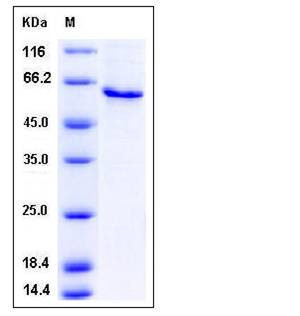Mouse SerpinB12 Protein (His Tag)
2300003F07Rik,4833409F13Rik
- 100ug (NPP2793) Please inquiry
| Catalog Number | P50565-M08B |
|---|---|
| Organism Species | Mouse |
| Host | Baculovirus-Insect Cells |
| Synonyms | 2300003F07Rik,4833409F13Rik |
| Molecular Weight | The recombinant mouse SERPINB12 consists of 434 amino acids and has a calculated molecular mass of 49.3 kDa. The apparent molecular mass of the protein is approximately 58 kDa in SDS-PAGE under reducing conditions. |
| predicted N | Met 1 |
| SDS-PAGE |  |
| Purity | > 92 % as determined by SDS-PAGE |
| Protein Construction | A DNA sequence encoding the mouse SERPINB12 (NP_082247.1) (Met 1-Pro 423) was expressed, with a C-terminal polyhistidine tag. |
| Bio-activity | |
| Research Area | Immunology |Inflammation / Inflammatory Mediator |Plasma Cascade Systems in Inflammation |Fibrinolysis System |
| Formulation | Lyophilized from sterile 50mM Tris, 100mM NaCl, 0.5mM PMSF, 10% glycerol, pH 7.4 1. Normally 5 % - 8 % trehalose and mannitol are added as protectants before lyophilization. Specific concentrations are included in the hardcopy of COA. |
| Background | Serpins are the largest and most diverse family of serine protease inhibitors which are involved in a number of fundamental biological processes such as blood coagulation, complement activation, fibrinolysis, angiogenesis, inflammation and tumor suppression and are expressed in a cell-specific manner. Most serpins are secreted and attain physiologic concentrations in the blood and extracellular fluids. Mouse SerpinB12 is a cytoplasm protein which belongs to the serpin family and Ov-serpin subfamily. It is expressed in many tissues, including brain, bone marrow, lymph node, heart, lung, liver, pancreas, testis, ovary, and intestine. SerpinB12 inhibits trypsin and plasmin, but not thrombin, coagulation factor Xa, or urokinase-type plasminogen activator. |
| Reference |
